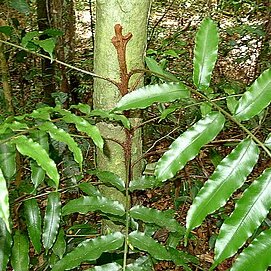Plants terrestrial [hemiepiphytic]. Stems long-creeping or climbing, stolons absent. Leaves strongly dimorphic, sterile ones longer and with wider pinnae than fertile ones, evergreen. Petiole ca. 1/2 length of blade, base not swollen; vascular bundles more than 3, arranged in an arc, ± round in cross section. Blade ovate-lanceolate, 1-pinnate, apex similar to lateral pinnae, papery. Pinnae articulate to rachis, sometimes deciduous, segment margins (pinnae) entire to serrate; proximal pinnae slightly reduced, sessile, equilateral; costae adaxially shallowly grooved, grooves not continuous from rachis to costae; indument of narrow scales abaxially, blades glabrous adaxially. Veins free, simple or forked, ± parallel perpendicular to costae. Sori covering abaxial surface of linear, entire pinnae; indusia absent. Spores brownish, with spiny or with prominent crested wings. x = 41.
Climbers, large. Rhizome long creeping on tree trunk, stout, bearing roots ventrally and fronds in 3-5 dorsal rows, dictyostelic, apex densely covered with black opaque scales. Stipes stramineous, often terete, gradually decurrent into ridges of rhizome; lamina simply pinnate, lateral pinnae articulate to rachis, terminal pinnae not so, pinnae equal, shortly stalked, lanceolate, leathery or papery, glabrescent, margin entire; veins all free, simple or forked, parallel and terminating at cartilaginous margin; fertile pinnae contracted, linear to linear-oblong. Sori acrostichoid, completely covering abaxial surface of pinnae; annulus consisting of 14-22 thick-walled cells. Spores monolete, brownish, elliptic. x = 41.
Climbing or scandent ferns. Rhizome long-creeping or scandent, densely scaly at the apex. Fronds dimorphic. Stipe decurrent on the rhizome. Lamina 1-pinnate (simple on juvenile growth); lateral pinnae articulated on the rachis; terminal pinna continuous with the rachis. Sterile lamina with broad pinnae. Fertile lamina with narrow pinnae. Veins free, simple or forked. Sporangia covering most of the ventral surface of the fertile pinnae. Spores ellipsoidal, monolete, with prominent wings.

